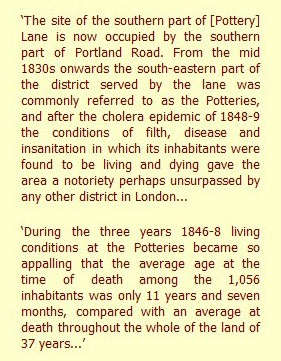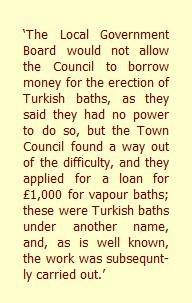This is a single frame, printer-friendly page taken from Malcolm Shifrin's website
Victorian Turkish Baths: their origin, development, and gradual decline
Visit the original page to see it in its context and with any included images or notes
4: Charges and class
When the London Hammam was opened in 1862, it was, relatively speaking, more expensive, charging 3/6 for male bathers and 5/- for females, while at the same time, a shampooer was being paid 25/- per week.
Urquhart was repeatedly at odds with his fellow directors over admission charges. For as well as arguing on behalf of the bath as a curative agent, he felt no less strongly that, in an age when most people were still without indoor water supplies, let alone bathrooms, the Turkish bath, as the most effective cleansing agent, should be available to all as inexpensively as possible.
While most establishments were as cheap (or cheaper) than Nevill’s, no-one was providing much-needed Turkish baths at something approaching cost price.
Locating London establishments on Booth’s 1889 poverty map shows
that they were rarely in the poorer areas where they were most needed; preferred
locations were more often adjacent to railway stations used by commuters
travelling home to the suburbs. However, for a number of reasons,
 I should not wish to draw too many unqualified conclusions from such an over-
simplified exercise.
I should not wish to draw too many unqualified conclusions from such an over-
simplified exercise.
Only one establishment provided free Turkish baths for needy Londoners.
In the mid 1860s, Richard Metcalfe set up a hydropathic dispensary and Turkish bath in the deprived Potteries area of Notting Hill as part of Mrs Bayley’s Ragged Castle and Workmen’s Hall. Mrs Bayley, more concerned with healthy souls than bodies, saw the bath as part of her armoury in the battle to convert the unwashed to temperance and Christianity.
Her landlord, on the other hand, saw it as a fire risk and had it closed down.
 When the first Baths and Wash-houses Acts were passed in 1846 and 1847, Turkish baths did not exist. This was very widely interpreted to mean that they could not legally be provided by local authorities, so none was built in London during the Victorian period.
When the first Baths and Wash-houses Acts were passed in 1846 and 1847, Turkish baths did not exist. This was very widely interpreted to mean that they could not legally be provided by local authorities, so none was built in London during the Victorian period.
But outside London, local politicians were occasionally more subtle. Southampton Corporation, for example, provided publicly funded Turkish baths by the simple, if risky, expedient of calling them—inaccurately, but pragmatically—vapour baths, and these were permitted under the Acts.
But there was a downside to this ruse: under the Acts, they had to provide First and Second Class Baths, just as they were legally bound to provide two classes of swimming pool.
Urquhart had seen the Turkish bath as enabling different classes to mix and get to know each other. But most private bath owners, though not covered by the Acts, voluntarily chose to distinguish first and second class bathers so as to enlarge their potential clientele.
Separate facilities were provided occasionally. But usually, second class bathers came at different times, at a lower price, sometimes having to bring their own towels, and often having to do without a massage.
Working class bathers faced another problem in some parts of London. As William Bishop, owner of the Putney Turkish baths, complained, pressure from Church and Chapel prevented his baths from opening on Sunday—the only day the working classes had sufficient time to use them.
This page revised and reformatted 02 January 2023
The original page includes one or more
enlargeable thumbnail images.
Any enlarged images, listed and linked below, can also be printed.
Minute book of the London & Provincial
Booth's Poverty Map of London, 1889

Victorian Turkish Baths: their origin, development, and gradual decline



Comments and queries are most welcome and can be sent to:
malcolm@victorianturkishbath.org
The right of Malcolm Shifrin to be identified as the author of this work
has been asserted by him
in accordance with the Copyright, Designs and Patents Act 1988
© Malcolm Shifrin, 1991-2023